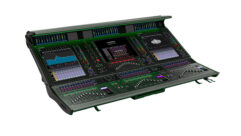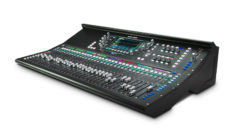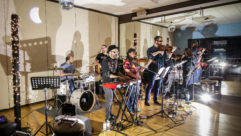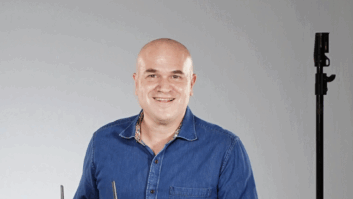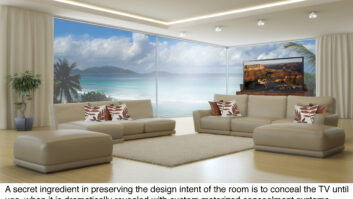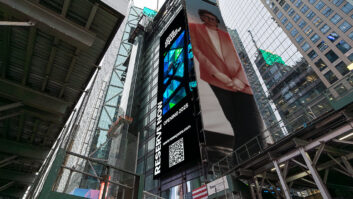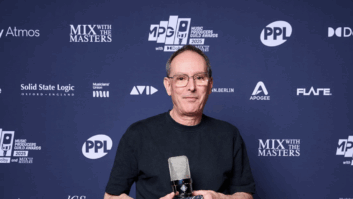
Technology Showcase: Live Digital Mixers
Oct 1, 2008 12:00 PM,
By Kent Morris
Improved user interfaces combine with expanded feature sets and reduced prices.

Roland RSS V-Mixing System
From mid-size churches to regional theaters, blues clubs to corporate venues, digital consoles have become the norm for new installations and retrofits. The flow away from analog toward digital continues to accelerate as user interfaces improve and features rise while prices drop. Though the demise of the analog console is still in the distant future, the trend is obvious: Live-performance environments are embracing digital at analog’s expense. Interestingly, since all sound begins and ends in an analog form, digital will always be a temporary state requiring analog-to-digital (A/D) converters on the front end and digital-to-analog (D/A) converters on the back end. However, digital shines in the interim mixing-and-storing state with its ability to save and recall complete scenes and reconfigure itself for myriad applications. As the digital choices continue to expand, consultants and designers are able to specify consoles oriented toward the task at hand and rely less on general-purpose devices. With ever more robust power supplies and improved fail-safe architecture, digital mixing consoles are a reliable, productive addition to any installation project. Here, then, is a closer look at the latest offerings in live digital mixers.

Allen & Heath iLive
With its modular approach to digital mixing, Allen & Heath‘s entry is enjoying good success across a number of genres. With up to 64 inputs driving an impressive 32 outputs, the iLive system can be considered a large-format design in a mid-format package. Based on an interface card system termed MixRack, iLive is able to fit almost any application without overspending for unwanted features. Flexibility is iLive’s longsuit, and the recent addition of an offline editor means the system can now be configured prior to the installation with less time spent onsite. Also new this year is the iLive configuration utility, making it possible to design a specialized system online through three menu screens — one each for the control surface, the MixRack, and accessories. Individual modules can be dropped into virtual slots until the desired system is complete. Once completed, the design can be sent to an Allen & Heath sales rep for order processing. The online configuration speeds the process and eliminates data-entry errors.

DiGiCo SD7
Six years into the D5 format, DiGiCo launches the SD7, which is based on the latest-generation Super FPGA (Field Programmable Gate Array) processor technology with its floating-point smoothness and linearity. The SD7 boasts an eight-fold increase in processing power compared to the company’s D5 Live, making it capable of stellar performance when called on to handle extremely large festivals and complex multimedia events. For reliability, the SD7 sports a completely redundant processing engine housed within a more compact frame compared to the standard-bearing D5. The company continues to offer the D1 and D5 family of mixers and update them as required.

Digidesign Venue
With years of digital experience in the Pro Tools recording realm, Digidesign was in an excellent position to parlay its knowledge into a solid live-console design. The result has been remarkable, with broad market acceptance based to some extent on Digidesign’s ability to cover FOH, monitor, and record positions with a singular product. With Venue, the live mix is run in the same format as the Pro Tools recording environment. The Venue series continues to impress with its stage-mounted, remote-controlled mic pres and separate FOH-positioned mix engine connected by a digital snake. Recent software updates have given the Venue increased versatility while maintaining TDM plug-in compatibility. On a smaller scale, the new D-Show Profile brings full Venue power to tighter environments while adding a useful new General Purpose Interface (GPI) with contact-closure switches.

EAW UMX.96
Though it’s considered solely a loudspeaker manufacturer, EAW is an integral part of the Loud Technologies empire. As such, it has benefitted from the console expertise of sister company Mackie. However, EAW’s offering in the digital-mixing realm, the UMX.96, is not an upmarket Mackie mixer. It is a serious approach to the FOH needs of large-format live events with available inputs in excess of 100 and outputs nearing four dozen. Thanks to Loud, EAW has also been able to incorporate SmaartLive, the industry-accepted audio-measurement and -calibration software, into the console. In addition, a full three-input, 12-output loudspeaker management processing system capable of handling a left, right mono mix into a stereo four-way loudspeaker system is integrated into the UMX.96. Further raiding of the Loud corporate parts bins resulted in a new loud-speaker processing card featuring Gunness Focusing technology to derive the highest potential from the transducers.
Technology Showcase: Live Digital Mixers
Oct 1, 2008 12:00 PM,
By Kent Morris
Improved user interfaces combine with expanded feature sets and reduced prices.
Innovation is a hallmark at Euphonix; the company first roared out of Palo Alto, Calif., two decades ago with digitally controlled large-format analog desks. The company’s more recent professional line, the System 5, is an all-digital structure with a solid reputation for performance. For smaller environments, Euphonix recently introduced the Artist Series, an Ethernet-based, protocol-shifting control surface for project studios. Over in its Professional Series, the company’s System 5-B continues to find favor in permanent installations despite its creator’s broadcast intent. The 5-B is versatile enough to function perfectly at FOH, thanks in part to a new Fiber Stagebox solution with 56 mic preamps each in a redundant MADI/LAN-over-fiber configuration. In situations in which audio posting is part of the equation, Euphonix offers the System 5-BP, a specialized on-air board with full mix automation to fulfill both roles in a single console.
For live sonic environments, Harrison Consoles offers two solutions: the Trion and the LPC. The sleek lines of the Trion give hint to the power beneath the surface. A trademark Wide Pipe architecture keeps signals at full bandwidth throughout the processing, while instant control-parameter access is ensured through a “knob per function” fold-out feature across any adjacent eight faders. For custom groupings, Trion has Profile, a way to map unique combinations of channels to the surface as needed in an instant. Finally, Trion’s high-resolution view screens are able to show every pertinent aspect of the signal simultaneously. The second live solution, the LPC (Live Production Console), was co-developed with live-event master Showco, and it features the user’s choice of an analog or digital processing engine. With onboard Harrison IKIS automation, every function on the console is instantly recallable.
Innovason, an early digital adopter, is stronger than ever — offering a new entry to the console marketplace. Despite its compact footprint, the Eclipse can handle more than 100 inputs and route them to four dozen mix busses. Building on Innovason’s concept of one-touch mixing, the Eclipse bristles with 48 faders and an evolutionary update of the original SmartFAD interface design, with assignable functions for all. Eclipse offers 48 more controls in the form of soft-programmable knobs for control over parameters such as gain and pan. In deference to the local point reference of analog consoles, Eclipse is equipped with an ID/value window at most points of adjustment, obviating the need to constantly refer to the primary mix screen. Finally, the Innovason engineers have added Multitrack Audio Recording System (MARS), a complete recording solution integrated into the console. MARS is a 64-track digital recorder designed to capture the entire mix without the need for any outboard equipment.

Mackie System32
A name synonymous with live sound makes good on its promise to cover the digital realm with the expanded TT System32. Based on the successful TT24 console, the Mackie System32 is a lower-cost alternative to the combination of a quality analog console, outboard DSP, and a digital snake. By incorporating all these components into a single package, Mackie delivers an amazing bang for the buck. The TT24 console boasts an internal touchscreen and optional external view-screen interface, 99 presets, a solid effects section, and four-band EQ. The DS3232 digital snake uses standard Cat-5 cabling to bring remote-level mic preamps to the console from up to 300ft. away while the U100 network card keeps track of the data. With 32 mic inputs and an equal number of returns, the TT System32 can fulfill the needs of all but the largest installations.
Technology Showcase: Live Digital Mixers
Oct 1, 2008 12:00 PM,
By Kent Morris
Improved user interfaces combine with expanded feature sets and reduced prices.

Midas Pro6
As the ad says, digital has gone Midas — a clever way to indicate the anticipation live-sound engineers had leading up to the introduction of the original XL8. Despite, or perhaps because of, its rarified asking price, the XL8 has become a commercial success — with installations in churches, in performance venues, and on the road with headlining acts. The XL8’s five independent bays afford the user the confidence to concentrate on the mix, assured that the console will function in almost any situation. Now word is out of a new Midas digital board, and engineers and designers wait once more to hear the details for what should prove to be a stunning sequel. The new console, named the Pro6, has the same AS50 architecture as the XL8 with the same advanced automation; a 64×35 layout (56 inputs on the work surface plus eight returns); and LRM mains outs. There are also 16 configurable aux and 16 matrices capable of being fed from any input source. Variable Control Association is an exciting new way to bring any voltage-controlled amplifier (VCA)-assigned channel to the master section. Additionally, newly developed and patented POP (population) groups are onboard, working like a standard VCA/DCA but without its associated VCA master fader. With a POP, the entire channel strip moves to the center for immediate control of, say, an acoustic breakdown during a rock band’s concert. When the acoustic set is finished, the channels are instantly reset to their original positions. Thanks to these innovations, two or more engineers can be on the board at once without interference. In summary, the Pro6 is proof some sequels are indeed better than the original.
The RSS V-Mixing System from Roland may become an AV-standard product birthed from the RSS division of one of the music industry’s iconic brands. With the programming resources of Roland and the high-band video expertise of sister company Edirol, RSS engineers have given the V-Mixing System an intuitive interface with 24 faders controlling 48 channels and a comprehensive DSP section complete with four stereo effects processors, graphic EQs, and built-in 24-bit stereo recording. One of the more significant attributes of the system is its integral digital snake using Cat-5e to deliver the company’s 24-bit Roland Ethernet Audio Communication (REAC) protocol hundreds of feet without signal degradation. With remote control of preamp levels and lossless digital splits for monitors, broadcast, and recording — along with digital returns to the amp racks — the V-Mixing System offers a turnkey solution for houses of worship, live-music venues, and regional theaters.
From Down Under, a new mix craze has emerged: the Tango by Smart AV. Designed as a low-cost, touchscreen-based solution in environments up to 48 inputs deep, the Tango benefits from the firm’s “Star Trek Enterprise” large-scale ARC technology. However, the Tango uses a scrolling screen overview display in association with touch selection of local channels for a total control capacity of 300 channels. Screen layouts can be configured for any application from general mixing to sound-effects spotting. All mixer controls are available visually in high resolution, and an extensive editor brings virtual keys into play for quick control of all editing parameters. The Tango represents an elegantly simple solution to the needs of the audio-installation market.

Soundcraft Vi4
The cool factor registers high on the Soundcraft Vi4 console if for no other reason than the Vistonics II interface with its rotary encoders (knobs) and switches residing directly on the touchscreens. Add in two dozen configurable (aux, group, or matrix) outputs, a digital snake with multiple-stage-box support, eight revered Lexicon stereo effects processors, and 27 BSS graphic EQs, and the Vi4 becomes a world-beater. The standard system consists of 48 inputs arranged on 24 faders, thoroughly detailed four-band EQ, compressor, limiter, and gate on each input and output — all running on a Cat-5 link to stage. There is a fiber-optic version available at a slight premium. In all, the engineering team at Soundcraft has taken the best of the big-brother Vi6 and packaged it nicely in a take-home size.
A tabletop version of a Studer console is an intriguing idea since the Studer name is never associated with anything unsubstantial. However, the company’s relatively small Vista 5 is a performance heavyweight, with unparalled sonic quality and the same operational principles as the Vista 6, 7, and 8. Inside the Vista 5, a newly developed Score Live DSP platform handles the number crunching with aplomb, to the tune of a total I/O capacity of 1700 points. Snapshot automation in conjunction with accessible mute groups and extensive matrix routing make the Vista 5 at home in FOH locations as diverse as churches and outdoor festivals.
Technology Showcase: Live Digital Mixers
Oct 1, 2008 12:00 PM,
By Kent Morris
Improved user interfaces combine with expanded feature sets and reduced prices.
The DM-3200 mixer was Tascam’s digital foray into the arena it knew well: production consoles. With the addition of the upscale DM-4800, the return is complete; Tascam has shown once again why it has been successful in formats as removed as cassettes and hard drives. The DM-4800 features 24 mic pres, expandable in 8-channel groups via four rear-panel card slots; a dozen aux sends to accommodate the most demanding monitor requirements; four-band EQ and gating per channel; and 24 busses to cover delay towers, cry rooms, balconies, and streaming. For recording-savvy HOWs, the DM-4800 provides a remote-layer control surface to handle digital audio workstations (DAWs) such as Digidesign Pro Tools, Steinberg Nuendo and Cubase, and Cakewalk Sonar. Tascam sought out the renowned effects gurus at TC Electronic for the console’s internal dual-effects processing and gave each aux, bus, and main output a variable compressor. Tascam offers a generous array of expansion cards — including FireWire interfaces; surround-sound monitoring; analog mic inputs; and separate cards for TDIF, ADAT, and AES/EBU formats.
With its new Commercial Audio division, Wheatstone is now addressing the live-sound installation market with the iXO processor. For hands-on mixing, the firm’s D-10 console delivers all its primary controls in a single surface without needing to resort to layering or function sharing for everything aside from EQ and dynamics. Strictly speaking, it’s a TV console, but the D-10 can easily fit into a live-performance format given its four-band parametric EQ with variable HPF and LPF per channel, eight subgroups, and comprehensive talkback section. For applications in which the house engineer is familiar with broadcast control or the venue is engaged in broadcasting its services or events, the D-10 can simplify the learning curve by providing a single point of audio control.

Yamaha M7CL
For a soup-to-nuts digital console menu, Yamaha is hard to beat. From the original flagship PM1D in all its updated glory to the recently introduced LS9 series of bantamweight champions, Yamaha delivers a smorgasbord of delectable dishes. The mid-line M7CL, with 32-channel and 48-channel models, has become a favorite of medium-sized churches and clubs by offering reliable performance in a single-layer (no menu pages) package. The M7CL’s touchscreen allows novice users to instantly grasp the console’s methodology, while a simple Centralogic section provides control from a single location on the board. USB ports are used to assign user hierarchy as well as off-site storage of system configurations. Meanwhile, the derivative LS9 models retain the M7CL’s layout in an even more compact footprint. Both 16-channel and 32-channel versions are available, each with dual-layer channel expansion control via rear-mounted card slots. Fully developed SPX-type effects are included, as well as graphic and parametric EQs and a host of compressors, limiters, and gates.
MORE INFORMATION
Allen & Heath
www.allen-heath.com
DiGiCo
www.digico.org
Digidesign
www.digidesign.com
EAW
www.eaw.com
Euphonix
www.euphonix.com
Harrison Consoles
www.harrisonconsoles.com
Innovason
www.innovason.com
Mackie
www.mackie.com
Roland
www.rssamerica.com
Smart AV
www.smartav.net
Soundcraft
www.soundcraft.com
Studer
www.studer.ch
Tascam
www.tascam.com
Wheatstone
www.wheatstone.com
Yamaha
www.yamahaca.com


